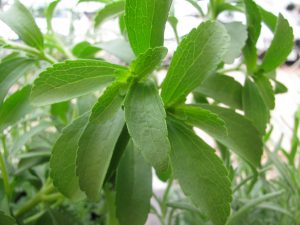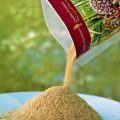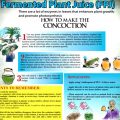It may sound foreign to most Filipinos but to many health-conscious persons, stevia (Stevia rebaudiana) has been around as a natural sweetener for several decades already.
Grown for its leaves as a sweetener and sugar substitute, stevia is reported to be native to tropical and subtropical regions in North and South America particularly in Paraguay. In the Philippines, some farmers drawn to the herbal medicine trend have started to experiment planting stevia in small areas.

Health benefits
Although known for its bitter or licorice-like aftertaste, stevia is highly-praised for its remarkable sweetness compared to sugar. Foreign literatures report that crude stevia leaves are 10-15 times sweeter than table sugar while steviosides or the refined stevia extract is reported to be 200-300 times sweeter than table sugar. Thus, it is priced as a low-carbohydrate, low-sugar content natural sweetener of food and drinks.
There are also literatures claiming the medical benefits of stevia including its use in treating obesity, hypertension, and diabetes. It may even help prevent dental cavities and promote healthier skin.
Acceptability
While it is widely cultivated and used in countries such as Paraguay, Brazil, Japan, and China for a considerably long time already, stevia is restricted (US, Australia, New Zealand, Canada, Switzerland, France, Mexico) or banned (Singapore, Hong Kong, Norway) in some countries which do not fully consider stevia as safe.
In 2006, the World Health Organization (WHO), in a joint effort with the Food and Agriculture Organization (FAO), published the results of its “Safety evaluation of certain food additives” including steviol glycosides, the natural constituents of stevia. According to the WHO, among the 10 different glycosides, the group of organic compounds found abundantly in plants that yield sugar, the major constituents are stevioside and rebaudioside A.
After performing a thorough evaluation, the WHO concluded that stevioside and rebaudioside A are not genotoxic or cause genetic mutations in vitro or in vivo and that the genotoxicity of steviol and some of its oxidative derivatives in vitro are not expressed in vivo. Moreover, the report found no evidence of carcinogenic activity and noted that stevioside has shown some evidence of pharmacological effects in patients with hypertension or those with type-2 diabetes.
The report concluded, however, that further study is required to determine the acceptable daily intake (ADI).
Controversy
Defenders of stevia have pointed out that the real reason behind the bad reputation placed on stevia is its being a naturally occurring herb. As such, stevia is not patentable and would therefore not benefit the huge artificial sweeteners industry. Hence, the restrictions to stevia are believed by some to be due only to industry pressure.
However, in 2008, developments in the USA changed the image of stevia. After previously banning stevia, the US Food and Drug Administration (FDA) declared stevia as ‘Generally Regarded as Safe (GRAS)’ and this opened the floodgates for its use in that country. This ruling allowed Cargill’s and Coca-Cola’s Truvia, and Pepsi Co.’s PureVia sweetener to be released. Both products use rebaudioside A derived from the stevia plant.
Market
Following the US regulatory approval, the global market for stevia sweeteners was reported to have already hit $500 million. The market research firm, Mintel, declared that this could reach $10B given a few more years in the mainstream market.
Mintel further stated that stevia is projected to penetrate 20 – 25 percent of the global sugar and sweetener market. It was also reported that, while the US-based Cargill is now a major producer of stevia, China remains the largest producer of stevia leaves and their extracts which are exported mainly to Japan.
Local initiatives
After becoming aware of the benefits and potentials of stevia in the market and in improving the income of farmers, the Bureau of Agricultural Research (BAR) supported initial studies to propagate stevia. The Bicolandia Greenfields Development Organization based in Naga City and its researcher/consultant, Dr. Ma. Elena F. Quimio, are the main proponents of a project that is exploring the adaptability of the crop under local conditions.
Since stevia is known to be quite adaptable to diverse climates particularly in the tropics, the proponents are in the process of establishing a nursery that will serve as a source of planting materials for evaluation by farmer-cooperators. The goal of the proponents is to collaborate with farmer cooperators, who are the beneficiaries of the project, in the documentation of the experience with the experimental crop and in the evaluation of results from propagating stevia that would help them to educate farmers on good agricultural practices and nursery production for stevia planting materials.
Opportunity
Besides the prospects of stevia in the market, the farmers might as well benefit from the natural ability of this herb to protect the farm. Stevia is likewise considered to have insect-repelling characteristics as it has a natural defense mechanism.Destructive pest and insects are turned-off by its very sweetness.
———————————
For more information about the stevia project of BAR, please contact:
Dr. Ma. Elena F. Quimio, PhD br/> Bicolandia Greenfields Development Organization, Inc.
24-1 Dayangdang, Naga City
Tel nos.: 054 811 6042; 054 473 3756; Email: mquimio@yahoo.com.au
References:
About Stevia. http://en.wikipedia.org/wiki/Stevia
Growing Stevia. http://www.stevia.net/growingstevia.htm
Is stevia a safe sweetener? http://blog.medbroadcast.com/?p=1652
Lever, Rob. 28 April 2010. Stevia herb shakes up global sweetener market. http://www.bworldonline.com/weekender/content.php?id=8641
Questions & Answers about Stevia. http://www.stevia.com/Stevia_Article.aspx?Id=2269
Stevia, A Victim of Industry Pressure. http://mariamaestevens.com/2010/10/21/stevia-a-victim-of-industry-pressure/
Stevia – Sweetener of Choice for Future Generations. http://www.healthy.net/scr/Article.aspx?Id=2413&xcntr=3
World Health Organization, 2006. Safety evaluation of certain food additives. http://www.zevia.com/who.pdf
By: Miko Jazmine J. Mojica, Bar Digest July-December 2010 Issue (Vol. 12 Nos. 3-4)







This is good..we will contact your group to provide us the seedlings to use.